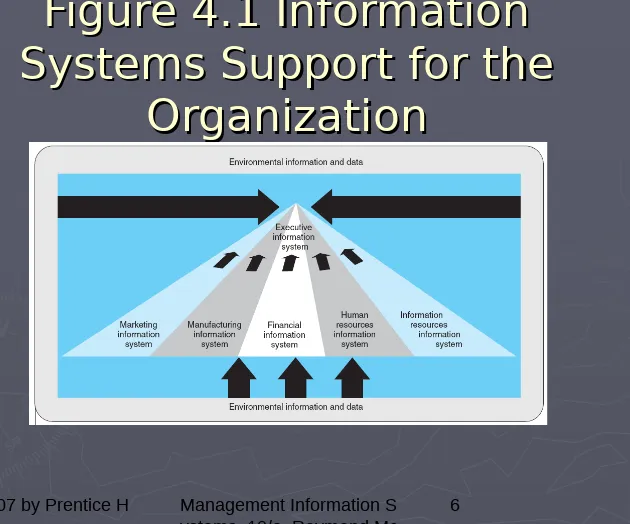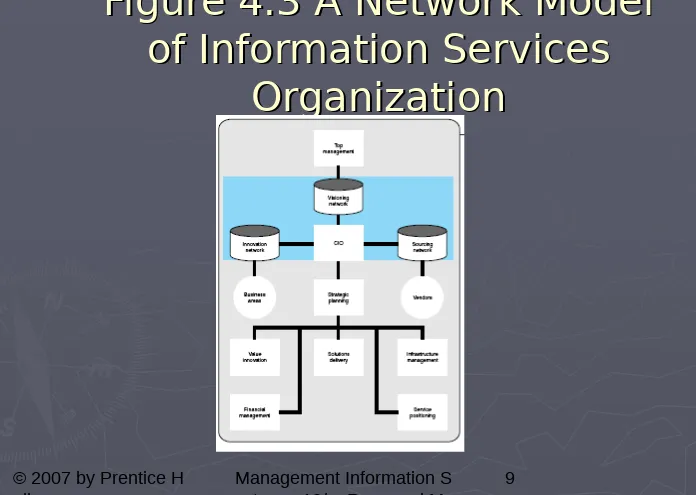Management
Management
Information Systems,
Information Systems,
10/e
10/e
Raymond McLeod and George
Raymond McLeod and George
Schell
© 2007 by Prentice Hall
© 2007 by Prentice Hall Management Information Systems, 10/e RManagement Information Systems, 10/e R
aymond McLeod and George Schell
aymond McLeod and George Schell
2
2
Chapter 4
Chapter 4
System Users and Developers
Learning Objectives
Learning Objectives
►
Know that the organizational content for
Know that the organizational content for
systems development and use is changing
systems development and use is changing
from a physical to a virtual structure.
from a physical to a virtual structure.
►
Know who the information specialists are
Know who the information specialists are
and how they can be integrated into an
and how they can be integrated into an
information services organization.
information services organization.
►
Be alert to new directions that the
Be alert to new directions that the
information services organization may take.
© 2007 by Prentice H all
Management Information S ystems, 10/e Raymond Mc Leod and George Schell
4
Learning Objectives (Cont’d)
Learning Objectives (Cont’d)
►
Understand what is meant by “end-
Understand what is meant by
“end-user computing” and why it came
user computing” and why it came
about.
about.
►
Appreciate that users, especially those
Appreciate that users, especially those
with an end-user computing capability,
with an end-user computing capability,
are a valuable information resource.
are a valuable information resource.
►
Know the benefits and risks of end-
Know the benefits and risks of
end-user computing.
Learning Objectives (Cont’d)
Learning Objectives (Cont’d)
►
Be aware of the types of knowledge and skill
Be aware of the types of knowledge and skill
that are important to systems development.
that are important to systems development.
►
Appreciate the value of managing the
Appreciate the value of managing the
knowledge held by information specialists
knowledge held by information specialists
and users.
and users.
►
Recognize the benefits and risks of the
Recognize the benefits and risks of the
virtual office and the virtual organization.
© 2007 by Prentice H all
Management Information S ystems, 10/e Raymond Mc Leod and George Schell
[image:6.720.73.703.2.526.2]6
Figure 4.1 Information
Figure 4.1 Information
Systems Support for the
Systems Support for the
Information Services (IS)
Information Services (IS)
Organization
Organization
►
Information resources
Information resources
►
Information specialists
Information specialists
System analysts
System analysts
Database administrators
Database administrators
Webmasters
Webmasters
Network specialists
Network specialists
Programmers
Programmers
© 2007 by Prentice H all
Management Information S ystems, 10/e Raymond Mc Leod and George Schell
8
IS Organizational Structure
IS Organizational Structure
►
Trend from centralized to decentralized
Trend from centralized to decentralized
structure.
structure.
Divisional information officer (DIO)
Divisional information officer (DIO)
►
Innovative
Innovative
Figure 4.3 A Network Model
Figure 4.3 A Network Model
of Information Services
of Information Services
Organization
© 2007 by Prentice H all
Management Information S ystems, 10/e Raymond Mc Leod and George Schell
10
Network Model (Cont’d)
Network Model (Cont’d)
►
Visioning network
Visioning network
enables the CIO
enables the CIO
to work with top mgmt. in strategic
to work with top mgmt. in strategic
planning for information resources.
planning for information resources.
►
Innovation network
Innovation network
is used by the
is used by the
CIO to interface with business areas
CIO to interface with business areas
so that innovations can be developed.
so that innovations can be developed.
►
Sourcing network
Sourcing network
is utilized to
is utilized to
interface with vendor for acquiring
interface with vendor for acquiring
information resources.
End-user Computing
End-user Computing
►
End-user computing
End-user computing
(
(
EUC
EUC
) is the
) is the
development by users of all or parts of
development by users of all or parts of
their information systems.
their information systems.
►
EUC has 4 main influences:
EUC has 4 main influences:
The impact of computer education.
The impact of computer education.
The information services backlog.
The information services backlog.
Low-cost hardware.
Low-cost hardware.
© 2007 by Prentice H all
Management Information S ystems, 10/e Raymond Mc Leod and George Schell
12
Benefits of EUC
Benefits of EUC
Risks of EUC
Risks of EUC
►
Poorly targeted systems.
Poorly targeted systems.
►
Poorly designed & documented
Poorly designed & documented
systems.
systems.
►
Inefficient use of information
Inefficient use of information
resources.
resources.
© 2007 by Prentice H all
Management Information S ystems, 10/e Raymond Mc Leod and George Schell
14
Education Criteria,
Education Criteria,
Knowledge, & Skills Needed
Knowledge, & Skills Needed
for IS Careers
for IS Careers
►
Systems development knowledge
Systems development knowledge
Computer literacy
Computer literacy
Information literacy
Information literacy
Business fundamentals
Business fundamentals
Systems theory
Systems theory
Systems development process
Systems development process
Systems life cycle (SLC) & Systems development
Systems life cycle (SLC) & Systems development
life cycle (SDLC)
life cycle (SDLC)
Table 4.1 Knowledge
Table 4.1 Knowledge
Requirements
© 2007 by Prentice H all
Management Information S ystems, 10/e Raymond Mc Leod and George Schell
16
Education Criteria, …(Cont’d)
Education Criteria, …(Cont’d)
►
Systems development skills
Systems development skills
Communications skills
Communications skills
Analytical ability
Analytical ability
Creativity
Creativity
© 2007 by Prentice H all
Management Information S ystems, 10/e Raymond Mc Leod and George Schell
18
Managing the Knowledge
Managing the Knowledge
►
Office automation
Office automation
includes all of the
includes all of the
formal & informal electronic systems
formal & informal electronic systems
primarily concerned with the
primarily concerned with the
communication of information to and
communication of information to and
from persons both inside and outside
from persons both inside and outside
the firm.
the firm.
►
Shift from clerical to mangerial
Shift from clerical to mangerial
problem solving.
Virtual Office
Virtual Office
►
Telecommuting
Telecommuting
describes how
describes how
employees could electronically
employees could electronically
“commute” to work.
“commute” to work.
►
Hoteling
Hoteling
is when the firm provides a
is when the firm provides a
central facility that can be shared by
central facility that can be shared by
employees as the need for office space
employees as the need for office space
and support arises.
© 2007 by Prentice H all
Management Information S ystems, 10/e Raymond Mc Leod and George Schell
20
Virtual Office (Cont’d)
Virtual Office (Cont’d)
►
Advantages
Advantages
Reduced facility cost.
Reduced facility cost.
Reduced equipment cost.
Reduced equipment cost.
Reduced work stoppages.
Reduced work stoppages.
Social contribution.
Social contribution.
►
Disadvantages
Disadvantages
Low morale.
Low morale.
Virtual Organization
Virtual Organization
►
Three I Economy
Three I Economy
is those industries
is those industries
that are most attracted to the concept
that are most attracted to the concept
of the virtual office & the virtual
of the virtual office & the virtual
organization and those that add value
organization and those that add value
in the form of
in the form of
information
information
,
,
ideas
ideas
, and
, and
intelligence
© 2007 by Prentice H all
Management Information S ystems, 10/e Raymond Mc Leod and George Schell
22
The Human Element
The Human Element
►
Most important ingredient in the
Most important ingredient in the
development & use of information
development & use of information
systems.
systems.
►
Main players
Main players
Users
Users

